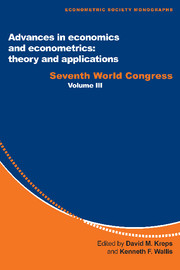Book contents
- Frontmatter
- 1 Causal analysis and statistical inference on possibly non-stationary time series
- 2 Cointegration, long-run comovements, and long-horizon forecasting
- 3 Testing and measurement in competition models
- 4 Empirical equilibrium search models
- 5 Posterior simulators in econometrics
- 6 Restricted least squares subject to monotonicity and concavity constraints
- 7 Bootstrap methods in econometrics: theory and numerical performance
- 8 Econometric models of option pricing errors
- 9 New minimum chi-square methods in empirical
- Index
6 - Restricted least squares subject to monotonicity and concavity constraints
Published online by Cambridge University Press: 05 January 2013
- Frontmatter
- 1 Causal analysis and statistical inference on possibly non-stationary time series
- 2 Cointegration, long-run comovements, and long-horizon forecasting
- 3 Testing and measurement in competition models
- 4 Empirical equilibrium search models
- 5 Posterior simulators in econometrics
- 6 Restricted least squares subject to monotonicity and concavity constraints
- 7 Bootstrap methods in econometrics: theory and numerical performance
- 8 Econometric models of option pricing errors
- 9 New minimum chi-square methods in empirical
- Index
Summary
INTRODUCTION
Economists have devoted much research effort to the estimation of cost functions and profit functions. Since the popularization of the dual approach to such functions, econometricians have focused particularly on methods for fitting functions that satisfy the restrictions implied by optimizing behavior, minimizing costs, or maximizing profits. For the most part, researchers have sought simple parametric functional forms that are sufficiently flexible to approximate well all possible cost and profit functions. Given such parametric functions, much of the estimation has followed the method of least squares.
In this chapter, I will describe a computational approach to fitting cost and profit functions by the method of least squares subject only to the restrictions imposed by the theory of optimizing behavior. Instead of tightly parameterized functional forms, I will use as many parameters as required to cover all the permissible functions. The computational approach has a long history, but this chapter grows specifically out of previous, joint research with my colleague, Steven Goldman. I will illustrate the computation with two examples drawn from the empirical literature on the estimation of cost functions.
There are several reasons to pursue the least-squares fit of cost and conditional factor demands. First of all, researchers have worked for many years on appropriate functional forms for these functions. Economists have proposed various parametric functional forms designed to exhibit their theoretical properties and to be amenable to conventional parametric statistical estimation methods.2 This requirement explains the popularity of such parametric cost functions as the translog.
- Type
- Chapter
- Information
- Advances in Economics and Econometrics: Theory and ApplicationsSeventh World Congress, pp. 166 - 187Publisher: Cambridge University PressPrint publication year: 1997
- 7
- Cited by



